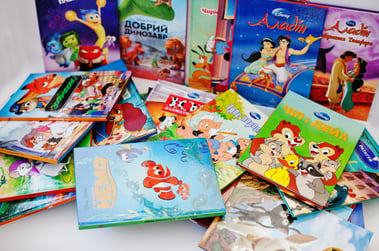The Magic Behind Disneyland: From Conception to Today
Walt Disney imagined a place where he can immerse people into his stories and a place where adults and children can enjoy together. But it didn't come easy or without its challenges.
2/6/20257 min read
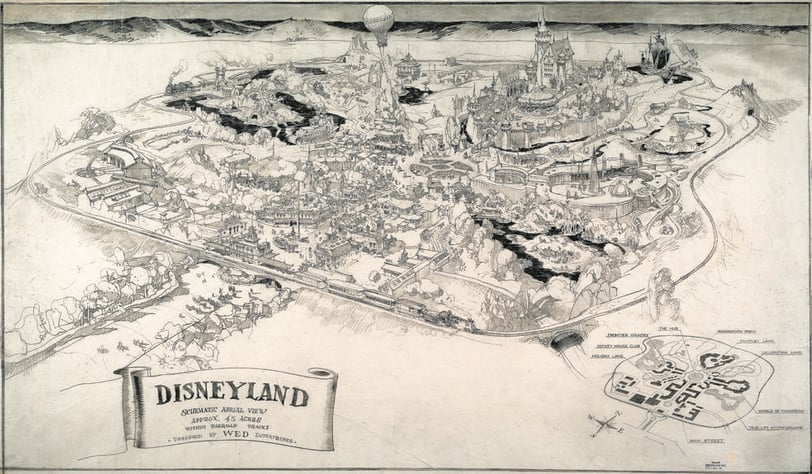

When Walt Disney first conceived the idea of Disneyland, he envisioned a place where families could enjoy an immersive experience of fantasy, adventure, and magic. From the very beginning, the creation of Disneyland was anything but ordinary, driven by Walt’s unique vision, an obsession with innovation, and a passion for storytelling. But what began as a dream on a napkin in 1953 has evolved into an iconic cultural and entertainment landmark, influencing theme parks around the world.
The Birth of Disneyland: A Dream Takes Shape
It all started in the early 1950s, when Walt Disney was disillusioned by the typical amusement parks of the time. He noticed how these parks were often dirty, overcrowded, and not exactly places where families could spend quality time together. Walt's idea was simple but ambitious: a theme park unlike any other, a place where children and adults could walk hand-in-hand through imaginative realms.
He was inspired by his own love for trains (a lifelong obsession), and his desire to create a destination that reflected his imaginative worlds of film. After making a bold decision to venture into the unknown, Walt began sketching ideas. Legend has it that he drew the first plans for Disneyland on a napkin while sitting at a table in the Disney Studio. The vision was grand — a 160-acre "theme park" where visitors could explore different lands, including Fantasyland, Tomorrowland, and Adventureland.
Finding a Home: The Anaheim Land Deal
In 1953, Walt Disney needed land. It took him several years of scouting before he found a location in Anaheim, California. But how did he pull off the real estate deal that would eventually make Disneyland a reality?
Disney’s land acquisition was done discreetly to avoid price inflation. Walt purchased parcels of land under fake names and different companies to prevent speculators from driving up the prices. At the time, Anaheim wasn’t much of a destination, and it was still seen as a largely agricultural area. But Disney’s vision for a magical world was far beyond the local expectations.
Fun fact: It’s rumored that Walt Disney took a personal trip to the land, driving around in a plain car under a fake name and quietly observing the area. Disney went as far as employing a real estate team that wore disguises, so the land prices wouldn't increase.
The Construction Begins: A Monumental Undertaking
Once the land was secured, the next hurdle was building the park. The task ahead was colossal, and the timeline seemed impossibly tight. Construction began in 1954, with Walt Disney overseeing every minute detail. The work was grueling, and Disney spared no expense. By the summer of 1955, the park was scheduled to open. However, Disneyland faced several challenges.
In an interesting twist, the opening of Disneyland on July 17, 1955, was marred by issues such as unfinished rides, a lack of proper plumbing, and even a strike by the construction workers. Furthermore, the opening day was so chaotic that the park’s first guests were often greeted with long lines and malfunctions. In fact, due to the tight timeline the asphalt on the Main Street wasn't laid till the night before and due to a heat wave in Southern California it began to melt and didn't have time to harden and set, causing high heels to get stuck in the pavement.
Despite the bumps along the way, the park officially opened to the public and quickly became a success, exceeding expectations.
The Secret Ingredients to Success: Walt’s Vision
What made Disneyland stand out was the relentless pursuit of perfection. Walt Disney was hands-on in almost every aspect of the park’s design and execution. He even installed hidden features and subtle details that were intended to enhance the experience.
One such example is the utilidors—the underground tunnels that allow cast members (employees) to move around the park unseen. This was Walt’s way of ensuring that there were no "behind-the-scenes" distractions for visitors. Guests walking through Disneyland’s pristine paths would never see the hustle and bustle of park operations. The tunnels are still in use today, and you can only catch a glimpse of them during special tours.
Another interesting detail involves the park's Main Street U.S.A.. Walt Disney wanted the street to reflect the small-town charm of a 1910 American town. The buildings on Main Street, however, were intentionally designed to be taller in proportion than the real buildings they were based on. This was done to give the illusion of a more grandiose space, adding to the whimsical sense of scale that permeates the park.
Disneyland’s Evolution: From Then to Now
Since its grand opening, Disneyland has undergone continuous changes and expansions. New lands, attractions, and technologies have been incorporated, creating an evolving experience. For instance:
New Lands and Attractions: Over the years, Disneyland has expanded from its original core of Adventureland, Fantasyland, Tomorrowland, and Main Street to include newer areas like New Orleans Square (which introduced the iconic Haunted Mansion), Critter Country, and Star Wars: Galaxy’s Edge.
Technological Innovation: Disney was always keen on innovation. The introduction of Audio-Animatronics in 1963, with attractions like the Enchanted Tiki Room, was a game-changer. It allowed characters to come to life in ways never seen before.
The Haunted Mansion Secret: The Haunted Mansion has long been one of Disneyland's most beloved rides. What most visitors don't know is that when the attraction first opened, it was intended to be a walk-through experience, not a ride. It was only after a series of challenges that the decision was made to turn it into the ride that we know today, complete with a “doom buggy” ride system.
The Disney Formula: The ongoing success of Disneyland led to the creation of a replicable "Disney formula." As the company expanded globally, this formula helped to establish Disney parks in places like Tokyo, Paris, and Shanghai. Each park carries elements of the original Disneyland but is adapted to fit the unique culture and environment of its location.
Hidden Facts and Easter Eggs
While Disneyland is undoubtedly famous for its iconic attractions, there are numerous lesser-known facts and secrets that remain hidden from most visitors:
The Window Names: Throughout Disneyland, you’ll notice small tribute windows on buildings on Main Street U.S.A. These windows are dedicated to influential members of the Disney team, many of whom were instrumental in shaping the park’s success. Walt Disney himself has a window honoring his name above the Main Street Emporium.
The Blueprints: The original blueprint for Disneyland was hidden in plain sight in the park for years. The first layout included secret details such as spaces for future expansions, and it's said that Walt Disney was especially fond of these blueprints, which were considered almost sacred by his team.
Walt’s Apartment: Above the Fire Station on Main Street, there’s a small, cozy apartment where Walt Disney occasionally stayed. A lamp was always left on in the window, signaling that Walt was in the park. Today, the lamp is still on whenever the park is open, as a tribute to Walt’s legacy.
Disneyland Today: A Global Icon
Since that fateful summer of 1955, Disneyland has evolved into a global entertainment empire. Today, it stands as the cornerstone of the Disney brand, with not only the original park in Anaheim but several international parks around the world. It continues to push the boundaries of immersive storytelling, technological innovations, and creating a sense of wonder for generations of families.
What started as a single theme park in Southern California has grown into a multi-billion-dollar industry that shapes pop culture and influences millions of people around the world. And even though much has changed since 1955, the underlying principles of Walt Disney’s vision—magic, imagination, and innovation—remain firmly intact.
So the next time you find yourself walking down Main Street, remember that you're not just visiting a theme park. You're stepping into a world created by a visionary who believed that with a little magic, anything was possible.
Click on the icon below to check out my Disney book collection on Amazon with stories about the creation and building of Disneyland in CA. You can also shop my favorite Disney merchandise items listed on Amazon.
Trivia question.
Due to a plumbers strike on Opening Day what did Walt have to choose between?
Answer. On Opening Day, a plumbers' strike left Walt with a tough decision: prioritize plumbing for the bathrooms or ensure there was drinking water available. Naturally, Walt chose to fix the plumbing, which meant guests couldn’t access free water from the drinking fountains and had to buy beverages instead. Many visitors at the time believed Walt was simply trying to increase profits, unaware of the difficult choice he had to make that day.
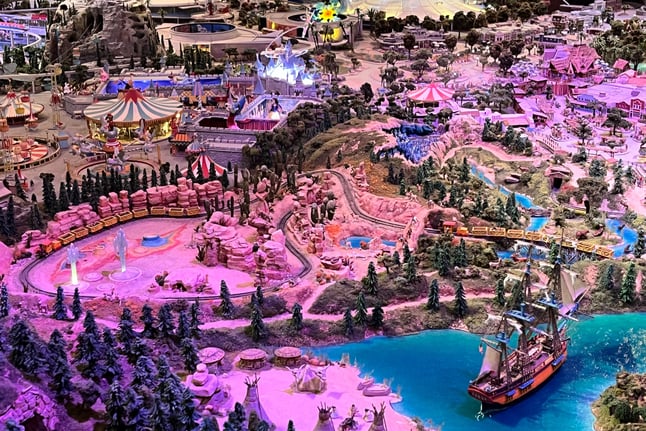

Herb Ryman's drawing of the first map of Disneyland in which Walt Disney and his brother used to secure funding for the project. You can see the drawing at the Walt Disney Family Museum.
Photo of Walt Disney's envision for Disneyland model at the Walt Disney Family Museum.
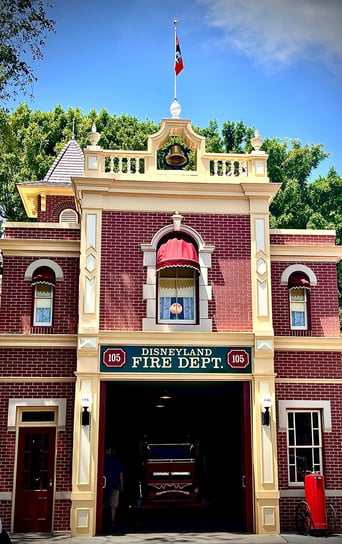

Photo of Walt Disney's apartment above Main Street U.S.A in Disneyland, CA.
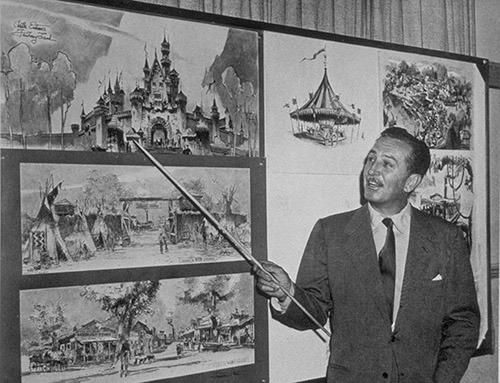

Walt Disney presenting his plans for Disneyland. Photo by Tom Simpson, via The Wall Breakers
*As an Amazon Associate, I earn from qualifying purchases.
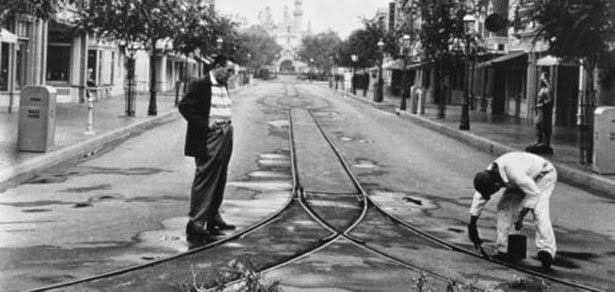

Walt Disney watching the final touches of Disneyland. Photo by Tom Simpson, via The Wall Breakers

